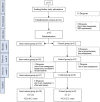Twelve weeks of physical exercise breaks with coordinative exercises at the workplace increase the sulcal depth and decrease gray matter volume in brain structures related to visuomotor processes
- PMID: 38070007
- PMCID: PMC10827861
- DOI: 10.1007/s00429-023-02732-w
Twelve weeks of physical exercise breaks with coordinative exercises at the workplace increase the sulcal depth and decrease gray matter volume in brain structures related to visuomotor processes
Abstract
Physical exercise can evoke changes in the brain structure. Consequently, these can lead to positive impacts on brain health. However, physical exercise studies including coordinative exercises are rare. Therefore, in this study, we investigated how 12 weeks of physical exercise breaks (PEBs) with coordinative exercises, focusing mainly on juggling tasks, affected the brain structure. The participants were randomly allocated to an intervention group (IG, n = 16; 42.8 ± 10.2 years) and a control group (CG, n = 9; 44.2 ± 12.3 years). The IG performed the PEBs with coordinative exercises twice per week for 15-20 min per session. Before the intervention, after 6 weeks of the intervention, and after 12 weeks of the intervention, participants underwent a high-resolution 3T T1-weighted magnetic resonance imagining scan. Juggling performance was assessed by measuring the time taken to perform a three-ball cascade. A surface-based analysis revealed an increase in vertex-wise cortical depth in a cluster including the inferior parietal lobe after 6 and 12 weeks of training in the IG. After 12 weeks, the IG showed a decrease in gray matter (GM) volume in a cluster primarily involving the right insula and the right operculum. The changes in the GM volume were related to improvements in juggling performance. No significant changes were found for the CG. To conclude, the present study showed that regular engagement in PEBs with coordinative exercises led to changes in brain structures strongly implicated in visuomotor processes involving hand and arm movements.
Keywords: Adult; Balance; Brain volume; Cortical thickness; Juggling.
© 2023. The Author(s).
Conflict of interest statement
The authors declare no conflict of interest.
Figures



Similar articles
-
Twelve Weeks of Web-Based Low to Moderate Physical Activity Breaks with Coordinative Exercises at the Workplace Increase Motor Skills but Not Motor Abilities in Office Workers-A Randomised Controlled Pilot Study.Int J Environ Res Public Health. 2023 Jan 25;20(3):2193. doi: 10.3390/ijerph20032193. Int J Environ Res Public Health. 2023. PMID: 36767561 Free PMC article. Clinical Trial.
-
Erratum.Mult Scler. 2016 Oct;22(12):NP9-NP11. doi: 10.1177/1352458515585718. Epub 2015 Jun 3. Mult Scler. 2016. PMID: 26041800
-
Effect of physical exercise on the hippocampus and global grey matter volume in breast cancer patients: A randomized controlled trial (PAM study).Neuroimage Clin. 2023;37:103292. doi: 10.1016/j.nicl.2022.103292. Epub 2022 Dec 14. Neuroimage Clin. 2023. PMID: 36565574 Free PMC article. Clinical Trial.
-
Test-retest reliability and sample size estimates after MRI scanner relocation.Neuroimage. 2020 May 1;211:116608. doi: 10.1016/j.neuroimage.2020.116608. Epub 2020 Feb 4. Neuroimage. 2020. PMID: 32032737
-
Time-source of neural plasticity in complex bimanual coordinative tasks: Juggling.Behav Brain Res. 2017 Jun 15;328:87-94. doi: 10.1016/j.bbr.2017.04.011. Epub 2017 Apr 11. Behav Brain Res. 2017. PMID: 28408297
References
-
- Baghdadi M, Badwey ME, Khalil M, Dawoud RM. Brain magnetic resonance imaging surface-based analysis and cortical thickness measurement in relapsing remission multiple sclerosis. Egypt J Radiol Nucl Med. 2022;53(1):8. doi: 10.1186/s43055-021-00686-9. - DOI
Publication types
MeSH terms
LinkOut - more resources
Full Text Sources

